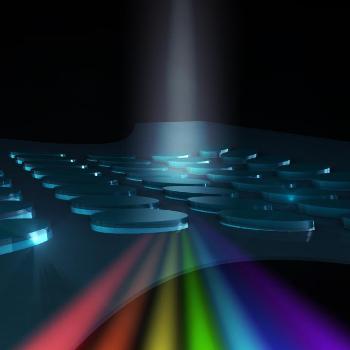A strechable, nano-scale device has been created which can be used to filter out specific wavelengths of light whilst itself remaining transparent. This technology could be used in the development of novel eye protection.
 Photo credit : RMIT/The University of Adelaide
Photo credit : RMIT/The University of Adelaide
The novel device is capable of manipulating light in a way that allows it to filter exact colors whilst still remaining transparent. This technology could be used in the development of smart contact lenses which could filter our hazardous optical radiation with no impairment of vision. A more sophisticated version could even gather data on the light input and transmit this remotely.
The manipulation of light is achieved by creating miniature artificial crystals called dielectric resonators; which are 100 to 200 nm, a size similar to the wavelength of light. These tiny crystals are more than 500 times thinner than a human hair.
This study leveraged the expertise of the University of Adelaide researchers and the RMIT University researchers. The former team has extensive knowledge about light’s interaction with artificial materials, while the latter team has know-how in materials science and nanofabrication.
Manipulation of light using these artificial crystals uses precise engineering.
With advanced techniques to control the properties of surfaces, we can dynamically control their filter properties, which allow us to potentially create devices for high data-rate optical communication or smart contact lenses.
The current challenge is that dielectric resonators only work for specific colours, but with our flexible surface we can adjust the operation range simply by stretching it.
Dr Withawat Withayachumnankul - University of Adelaide
The devices were created using a rubber-like material which is used for contact lenses.
We embed precisely-controlled crystals of titanium oxide, a material that is usually found in sunscreen, in these soft and pliable materials.
Both materials are proven to be bio-compatible, forming an ideal platform for wearable optical devices.
By engineering the shape of these common materials, we can create a device that changes properties when stretched. This modifies the way the light interacts with and travels through the device, which holds promise of making smart contact lenses and stretchable colour changing surfaces.
Associate Professor Madhu Bhaskaran - RMIT
The team was overcame a big scientific obstacle when they successfully combined the rubber-like material with high temperature processed titanium dioxide to create a material with nanoscale features.
With this technology, we now have the ability to develop light weight wearable optical components which also allow for the creation of futuristic devices such as smart contact lenses or flexible ultrathin smartphone cameras.
Dr. Philipp Gutruf - RMIT
The research has been published in the journal ACS Nano.